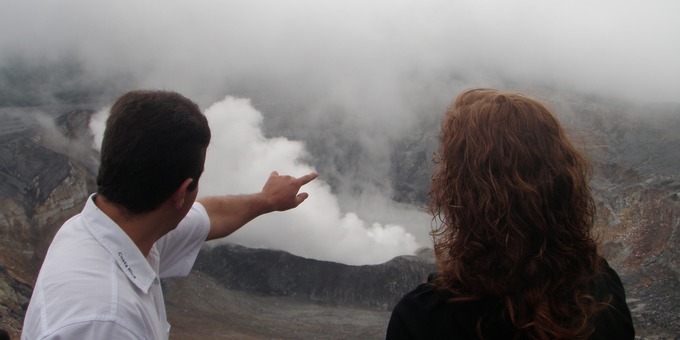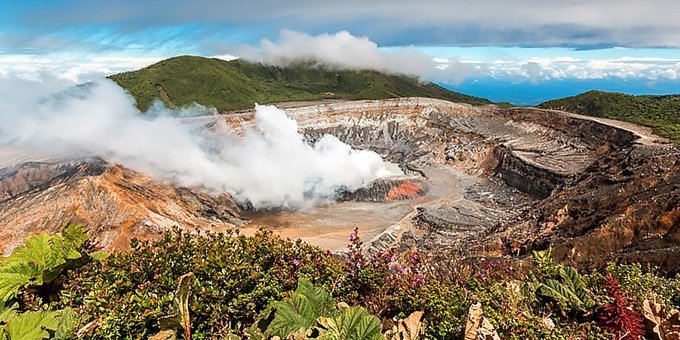
Nestled within the heart of Costa Rica's Central Volcanic Mountain Range, Poás Volcano National Park is a testament to the raw, breathtaking power of nature. Spanning over 16,000 acres, this park is a realm of geological wonders, lush cloud forests, and captivating biodiversity. At its heart lies Poás Volcano, one of the most active volcanoes in the country, boasting one of the world's largest volcanic craters. The park beckons explorers with its steaming fumaroles, pristine lakes, and enchanting cloud-shrouded forests that teem with life.

The Geological Marvel of Poás Volcano
The centerpiece of Poás Volcano National Park is the mighty Poás Volcano itself. Towering at an elevation of 8,885 feet (2,708 meters), this stratovolcano is renowned for its immense crater, one of the largest of its kind globally. The main crater, known as the "Active Crater," is a sight to behold. Within its depths lies a pristine, azure-green, rain-fed lagoon that adds an otherworldly charm to the rugged landscape. Visitors can gaze in awe at the bubbling cauldron of geothermal activity that churns within, producing billows of steam and occasional eruptions.
Geothermal Marvels: Fumaroles and Geysers
As you venture into the park, you'll encounter a surreal world of geothermal wonders. The hiking trails lead you to ethereal landscapes where plumes of steam rise from the ground, and the Earth's inner energy is palpable. The "Volcano's Overlook Trail" provides a vantage point for witnessing the remarkable fumaroles—openings in the Earth's crust that emit volcanic gases and steam. The experience is a sensory journey, with the hissing of steam, the pungent scent of sulfur, and the sight of the Earth's subterranean forces in action.
Biodiversity in the Cloud Forests
Beyond its volcanic marvels, Poás Volcano National Park is a haven of biodiversity. The park's cloud forests cloak the slopes of the volcano and harbor a rich tapestry of life. Moss-covered trees, epiphytic orchids, and vibrant bromeliads create a lush, otherworldly atmosphere. The cloud forests are home to a diverse array of flora and fauna, including the resplendent quetzal, hummingbirds, butterflies, and elusive mammals such as the ocelot and puma.
Lake Botos: A Pristine Alpine Gem
A short hike from the main crater takes you to Lake Botos, an enchanting alpine lake nestled within the lush cloud forest. Surrounded by dense vegetation, the lake's emerald waters reflect the verdant canopy above, creating a serene and picturesque setting. Visitors can take in the serenity of the lake from the viewing platform and immerse themselves in the beauty of this high-altitude oasis.

A Tale of Two Craters: Poás and Botos
Poás Volcano National Park offers a unique opportunity to explore two distinct craters in close proximity. The contrast between the active, fumarole-studded Poás Crater and the tranquil, forest-fringed Lake Botos Crater is a testament to the geological diversity of the area. It's a fascinating journey through time, where you can witness the dynamic forces that have shaped the landscape.
The Park's Remarkable Resilience
Poás Volcano National Park has faced challenges, including eruptions and environmental changes. In recent years, it has displayed remarkable resilience. After a period of volcanic activity that led to temporary closures, the park has reopened to the delight of visitors eager to witness its wonders. The regrowth of vegetation in the wake of eruptions showcases the incredible ability of nature to rebound and thrive.
Exploration and Conservation
As you explore the trails and viewpoints of Poás Volcano National Park, you become part of a broader conservation effort. The park plays a vital role in preserving Costa Rica's natural heritage and educating visitors about the importance of protecting these unique ecosystems. Your visit supports ongoing research and conservation initiatives aimed at safeguarding the park's biodiversity and geological wonders for generations to come.
Visiting Poás Volcano National Park
Poás Volcano National Park is easily accessible from San José, making it a popular day trip destination. Visitors should check with park authorities for the latest information on park hours, trail conditions, and safety regulations. To access the park, you must purchase tickets either through a registered tour guide or through the park service's official website. Guided tours are available, providing valuable insights into the park's geology, ecology, and conservation efforts.
In conclusion, Poás Volcano National Park is a captivating destination where the dynamic forces of geology meet the tranquility of cloud forests. It's a place to marvel at the Earth's inner workings, immerse yourself in biodiverse ecosystems, and appreciate the resilience of nature. Whether you're an avid hiker, a nature enthusiast, or a curious traveler, Poás Volcano National Park offers an unforgettable journey into the heart of Costa Rica's volcanic majesty.
Located in a mixture of rainforest and cloud forest, the weather in Poas Volcano National Park is fairly predictable. Expect warm early afternoons and cool and damp conditions in the morning and late afternoons. Daytime temperatures average in the mid 70s with night time lows averaging in the upper 50s. The most consistent rain is experienced between the months of May through November with the heaviest rains September through November.
Visitors should pack shorts, tee shirts, appropriate shoes, rain gear, sun block. It is also advised to bring at least one pair of pants, a long sleeve shirt, and even a sweat shirt or light jacket.
Fun Fact: Poas Volcano has the second largest volcanic crater in the world.
| Grecia | 30 km |
| Alajuela | 27 km |
| Heredia-Poas | 38 km |
| Escazu | 48 km |
| La Fortuna and Arenal Volcano | 107 km |
Latitude: N 10° 13' 3.36"
Longitude: W 84° 13' 55.92"
Unsure of what to do? Let us make you a free custom trip plan!